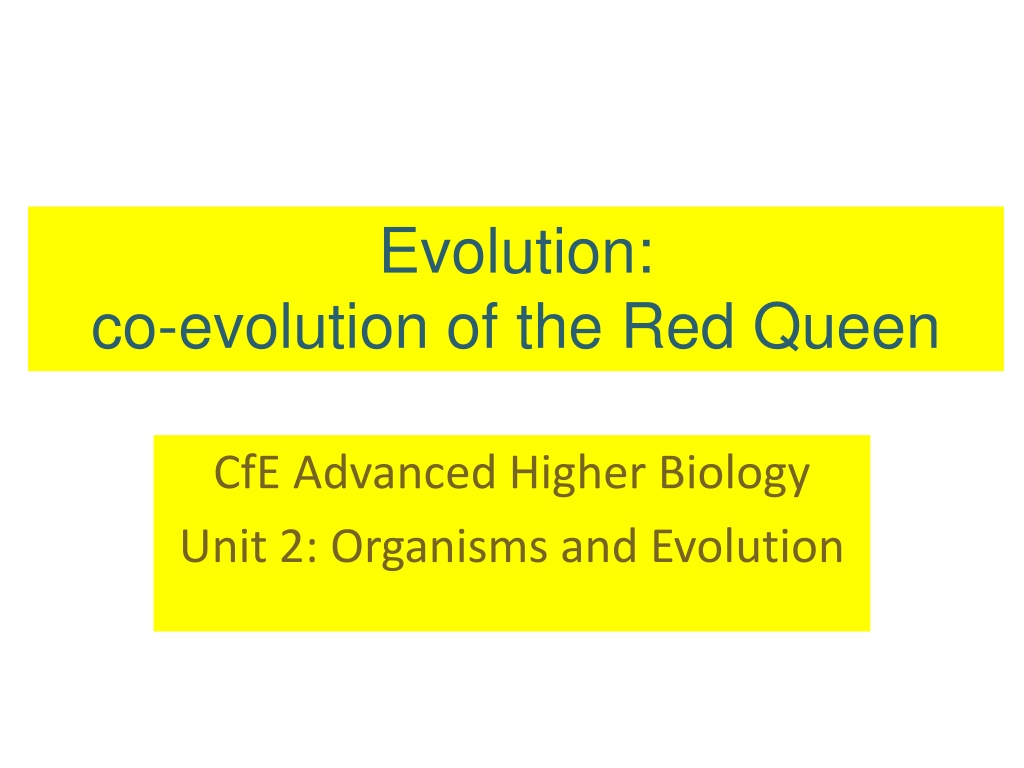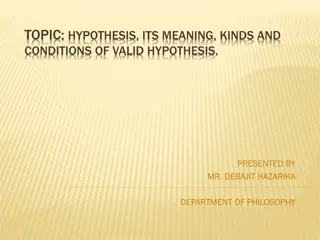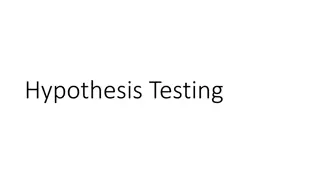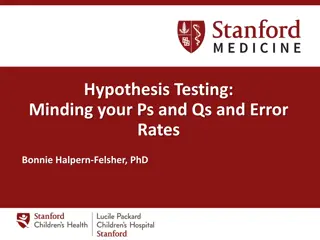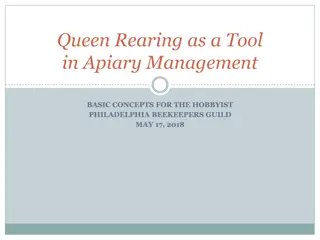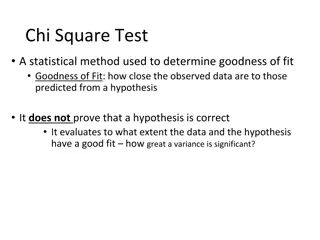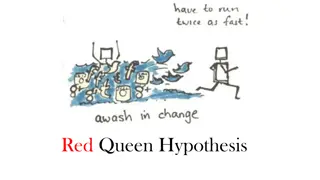Understanding Co-evolution: A Closer Look at the Red Queen Hypothesis in Biology
Co-evolution refers to the reciprocal genetic changes in species in response to each other. The Red Queen Hypothesis, illustrated in the arms race between parasites and hosts, exemplifies this phenomenon. This interaction drives evolutionary dynamics in herbivores, plants, pollinators, prey, predators, and more. Herbivores and plants, for instance, showcase a co-evolutionary dance of physical and chemical adaptations for defense and consumption.
Download Presentation

Please find below an Image/Link to download the presentation.
The content on the website is provided AS IS for your information and personal use only. It may not be sold, licensed, or shared on other websites without obtaining consent from the author. Download presentation by click this link. If you encounter any issues during the download, it is possible that the publisher has removed the file from their server.
E N D
Presentation Transcript
Evolution: co-evolution of the Red Queen CfE Advanced Higher Biology Unit 2: Organisms and Evolution
SQA mandatory key information A change in the traits of one species acts as a selection pressure on the other species. Co-evolutionary arms race between a parasite and host as an example of the Red Queen Hypothesis. WATCH: https://www.youtube.com/watch?v=a 8GMNEg6c6U
Key concepts Co-evolution is frequently seen in pairs of species that interact frequently or closely. Examples include herbivores and plants, pollinators and plants, predators and their prey, and parasites and their hosts The co-evolutionary arms race between a parasite and host is known as the Red Queen Hypothesis as both organisms must keep running in order to stay still . Hosts better able to resist and tolerate parasitism have greater fitness. Parasites better able to feed, reproduce and find new hosts have greater fitness.
What is co-evolution? Definition - The term co-evolution describes a change in the genetic characteristics of one (or more) species in response to a change in the genetic characteristics of another. It is a reciprocal arrangement where two of more species affect each others evolution. Co-evolution is frequently seen in pairs of species that interact frequently of closely. Examples of these strong ecological interactions include: Herbivores and plants Pollinators and plants Predators and prey Parasites and hosts
Herbivores and Pplants Herbivorous defences: Plants have evolved an impressive array of physical and chemical defences to avoid herbivory. Herbivores need to eat plants in order to obtain energy and have therefore coevolved mechanisms to overcome these defences. Physical adaptations Herbivores have evolved specially adapted teeth allowing them to break down their plant of choice. Herbivorous mammals have large molars for crushing and grinding material whereas seed eating birds have specially adapted beaks.
Herbivores and plants Chemical adaptations Some herbivores are able to detoxify plant secondary metabolites (PSMs) which are used by plants as chemical defences. It was found that the common brushtail possums (Trichosurus vulpecula) use various combinations of oxidation, hydrolysis, and conjugation with glucuronic acid (GA) or glycine to detoxify six PSMs to their evolutionary advantage.
Herbivores and plants Herbivores can also increase their success in obtaining food through behavioural adaptations such as eating plants at different times of the growing season when tannins and chemical toxins are lower. They can also use symbiotic relationships with cellulose digesting bacteria to allow them to break down the tough plant structural protein eg. ruminants. How do plants defend themselves against herbivore attack? Physical defences eg. stings, thorns and spines. eg. Thorns on an Acacia Tree, Acacia smallii eg. spines on a Blackberry plant, Rubus fruticosus eg. stinging nettle, Urtica dioica
Herbivores and plants How else do plants defend themselves against herbivore attack? Chemical defences: Production of tannins and cyanides Isolation of affected areas: Production of resins to localise fungal and bacterial infection and prevent spread to the rest of the plant. Mechanisms to reduce the effect of grazing: Low growing point (meristems), good powers of regeneration. Pine resin Pinus radiata surrounds areas of infection and limits spread. Lima beans or butter beans Phaseolus lunatus are one of many plants that contain cyanide.
Pollinators and plants Tegeticulamoths pollinate Yucca flowers. Moths are nocturnal and have a good sense of smell. The Yucca flower is white and therefore visible at night and has a sweet smell. Yucca flowers are a certain shape so only that tiny moth can pollinate them. The moths lay their eggs in the yucca flowers and the larvae (caterpillars) live in the developing ovary and eat yucca seeds.
Pollinators and plants Acacia ants Pseudomyrmex ferruginea on Acacia trees. Acacias are small, Central American trees. They have large, hollow thorns. The acacia ants live in the thorns. On the tips of its leaflets, the plant makes a substance used by the ants as food. The ants defend the tree from herbivores by attacking/stinging any animal that even accidentally brushes up against the plant. The ants also prune off seedlings of any other plants that sprout under their tree.
Predators and their prey Predation in Biology is defined as: The interaction between populations in which one organism (the predator) consumes another (the prey). Typically, the predator catches, kills and eats its prey but predation is also used to describe feeding by insectivorous plants and even grazing by herbivores.
Predators and their prey Lions and Zebra: The fastest lions are able to catch food and eat, so they survive and reproduce, and gradually, faster lions make up more and more of the population. The fastest zebras are able to escape the lions, so they survive and reproduce, and gradually, faster zebras make up more and more of the population. An important thing to realize is that as both organisms become faster to adapt to their environments, their relationship remains the same. This is true in all predator-prey relationships.
Predators and their prey Polar bears and seals: In this Arctic environment, the white coat of the polar bear makes it hard to spot against the snow but seal pups are also white so they can t be seen by the Polar bear! Australian broadheaded snake feeds primarily on velvet geckos. Velvet geckos that are in the same environment as the snakes are able to detect and react to the scent of the snake and avoid entering crevices where the smell has been detected.
Parasites and their hosts In co-evolution, a change in the traits of one species acts as a selection pressure on the other species. According to the Oxford Dictionary the definition of a parasite is: An organism which lives in or on another organism (its host) and benefits by deriving nutrients at the other s expense. Examples of co-evolution of parasites and hosts: Influenza and its human hosts - Influenza is an example of an RNA virus and it has many hosts. As we race to develop flu vaccines on an annual basis, the virus is more than able to keep up the evolutionary arms race due to the fact it has a high rate of mutation.
Parasites and their hosts The nematode Caenorhabditis elegans and its bacterial microparasite Bacillus thuringiensis. Both organisms have been extensively studied and evidence of mutual co evolution and genetic change were found. The relationship between a parasite and its host is very dynamic. This co-evolutionary arms race is known as the Red Queen Hypothesis. The term is taken from the Red Queen's race in Lewis Carroll's Through the Looking-Glass. The Red Queen said: "It takes all the running you can do, to keep in the same place."
Entrance of The Red Queen The Red Queen Principle can be stated as follows: In reference to an evolutionary system, continuing adaptation is needed in order for a species to maintain its relative fitness amongst the systems being co-evolved with. What this means: Hosts better able to resist and tolerate parasitism have greater fitness. Parasites better able to feed, reproduce and find new hosts have greater fitness.
An example of The Red Queen The New Zealand freshwater snail Potamopyrgus antipodarum and its different trematode parasites represent a rather special model system. Populations of P. antipodarum consist of asexual clones and sexual individuals and therefore can be used to study the evolution and advantages of sexual reproduction. Long term laboratory experiments and field studies revealed that there is a high correlation between the presence of parasites and the frequency of sexual individuals within the different populations. This result is consistent with the Red Queen hypothesis that sexual reproduction is favoured during host parasite co evolution
TUTORIAL 1: Selection Tutorial Read chapter 1 of The Red Queen: You will be given 1 discussion point to research. You must then be prepared to be able to answer fully and promote discussion on your question with the rest of the class during the tutorial.
